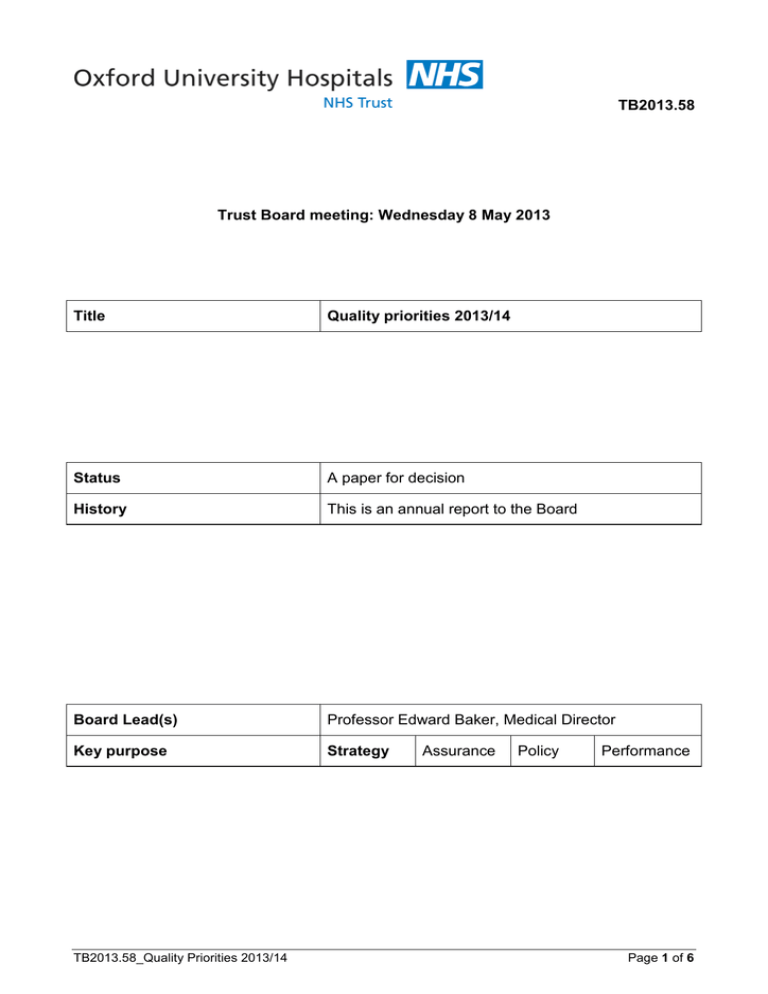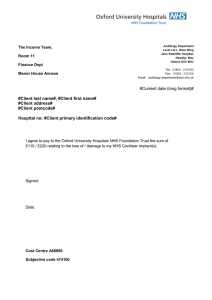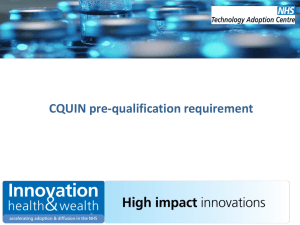TB2013.58 Trust Board meeting: Wednesday 8 May 2013 Title
advertisement

TB2013.58 Trust Board meeting: Wednesday 8 May 2013 Title Quality priorities 2013/14 Status A paper for decision History This is an annual report to the Board Board Lead(s) Professor Edward Baker, Medical Director Key purpose Strategy TB2013.58_Quality Priorities 2013/14 Assurance Policy Performance Page 1 of 6 Oxford University Hospitals TB2013.58 Summary 1 The quality priorities for Oxford University Hospitals NHS Trust for 2013/14 have taken into account national guidance, as set out in the National Outcomes Framework, national CQUIN priorities for 2013/14 and local priorities identified by the commissioner, stakeholder groups and Divisional teams. The NHS Outcomes Framework has five key domains for 2013/14. 2 All Divisions have identified local quality priorities and outcomes for 2013/14 based on current performance, and have assessed risks related to patient experience, safety and effectiveness and outcomes. Many Divisional priorities relate to the high level priorities identified in national guidance. 3 National guidance suggests that one fifth of the entire CQUIN for the contract links to the national CQUIN goals where they apply. All four national goals are appropriate for the OUH, so it is expected that all four goals will be equally weighted and account for 0.125% of the contract value. 4 Quality Account priorities have where possible have been aligned with CQUINs. Contribution from the general public was received at the Patient Engagement Event on 11 March 2013 to determine the final agreed Quality Account priorities 5 The Trust Board is asked to agree the quality priorities for 2013/14 and note processes in place to deliver the priorities in 2013/14. TB2013.58_Quality Priorities 2013/14 Page 2 of 6 Oxford University Hospitals TB2013.58 National Context for Quality Priorities 1. The quality priorities for Oxford University Hospitals NHS Trust for 2013/14 have taken into account a range of national guidance and local priorities including the NHS Outcomes Framework, national and local CQUINs, Trust Development Authority requirements and Divisional priorities. 2. National guidance has stated that from April 2013, compliance with high impact innovations has become a prequalification requirement for CQUIN. In order for providers to qualify for CQUIN payments, they will need to satisfy at least 50 per cent of the pre-qualification criteria that apply to them. 3. The Trust’s Annual Quality Account for 2012/13 will be published on the 30th June on NHS Choices, and will include key quality priorities for 2013/14 4. Based on their current performance and assessed risks, all Divisions have agreed local quality priorities for 2013/14 against the three domains of patient safety, patient experience, and clinical effectiveness & outcomes. These priorities will be monitored by the Clinical Governance Committee and included in the monthly Divisional quality reports. 5. The development of the local quality priorities supports the trust’s Quality Strategy, and local quality priorities are now in the process of being displayed in public areas across the Trust. The NHS Outcomes Framework 6. The NHS Outcomes Framework has five key domains for 2013/14. The proposed National Quality Dashboard is being developed to provide Trust-, Clinical Commissioning Groupand NHS-wide analyses of performance using 20 high level key quality indicators related to the five domains. The focus will be on improvement goals and is designed: 6.1.1. to provide a national level overview of how well the NHS is performing; 6.1.2. to provide an accountability mechanism between the Secretary of State for Health and the NHS Commissioning Board for the effective spend of some £95bn of public money; and 6.1.3. to act as a catalyst for driving up quality throughout the NHS by encouraging a change in culture and behaviour. TB2013.58_Quality Priorities 2013/14 Page 3 of 6 Oxford University Hospitals TB2013.58 Quality Account 2013/14 7. Quality Account priorities will continue to be aligned with CQUINs. Contribution from the general public was received at the Patient Engagement Event on 11 March 2013 to determine the final agreed Quality Account priorities. PATIENT SAFETY Safer care associated with surgery Includes improving outcomes for elderly frail patients post-surgery, consent & reducing avoidable readmissions Using technology to improve care Includes human factors training CLINICAL EFFECTIVENESS PATIENT EXPERIENCE Improving the way we listen to, and engage with, our patients Improving care for people with cognitive impairment Table 1: Quality Account Quality Priorities for 2013/14 Contracting for Quality & Innovation (CQUIN) 2013-14 8. National guidance has stated that from April 2013, compliance with high impact innovations is a prequalification requirement for CQUIN. In order for providers to qualify for CQUIN payments, they will need to satisfy at least 50 per cent of the pre-qualification criteria that apply to them. 9. In addition, it is suggested that one fifth of the entire CQUIN for the contract links to the national CQUIN goals where they apply. All four national goals are appropriate for the OUH, so it is expected that all four goals will be equally weighted and account for 0.125% of the contract value. 9.1.1. Friends and Family Test. The test will involve the use of a simple question, which is asked of all patients in the target groups. 9.1.2. NHS Safety Thermometer For those organisations that have established their baseline data (which is appropriate for the OUH) and received payment for doing so using the NHS Safety Thermometer TB2013.58_Quality Priorities 2013/14 Page 4 of 6 Oxford University Hospitals TB2013.58 CQUIN in 2012/13, the CQUIN will incentivise a locally agreed improvement goal. Organisations are recommended to prioritise improvement in pressure ulcer prevalence. 9.1.3. Dementia The goal of this CQUIN is to incentivise the identification of patients with dementia and other causes of cognitive impairment alongside their other medical conditions, to prompt appropriate referral and follow up after they leave hospital and to ensure that hospitals deliver high quality care to people with dementia and support their carers. 9.1.4. Venous Thromboembolism The aim of this CQUIN is to reduce avoidable death, disability and chronic ill health from venous thromboembolism (VTE). High impact innovations (Pre-qualifying CQUINs) National CQUINS Local CQUINS • Telemedicine to provide whole system care delivery close to home • Intra operative Doppler monitoring to improve safety and outcome of surgery • Child in a Chair in a Day • Digital first: Management of gestational diabetes Improving physiological outcomes after a heart attack Expanding and improving the electronic laboratory and radiology ordering and reporting service • Friends and Family Test – increase response rate of patients in the acute wards and the Emergency Department. Achieving a response rate in the top 50%. • Increasing the score of the Friends and Family test question in the 2013/14 staff survey against 2012/13 results. • NHS Safety Thermometer – focus on pressure ulcer reduction • Dementia – assessment, leadership and support/advice for carers • VTE – target has been increased to 95% • Psychiatric Liaison • Baseline data for frail elderly patients • Medical outreach for complex elderly patients in surgery • Emergency Admission Navigators • Nursing (and Care Support Worker Development) • Patients with learning disabilities who present with seizures • Diabetic foot disease • Supporting young adults with diabetes • Human Factors Training of staff, for patient safety Table 2: CQUINs for 2013/14 TB2013.58_Quality Priorities 2013/14 Page 5 of 6 Oxford University Hospitals TB2013.58 Implementation and monitoring 10. The lead manager for CQUINs and the Annual Quality Account will provide leadership and project management, working with designated leads for quality priorities set out in the Quality Account and CQUINs. This will include a trajectory of measurable milestones to be achieved throughout the year. 11. Regular progress will be monitored in performance meetings and regular progress reports and associated metrics will be submitted to the Clinical Governance Committee, Quality Committee and Trust Board. 12. The Trust Board is asked to: Recommendations • Agree the quality priorities for 2013/14 • Note processes in place to deliver the priorities in 2013/14. Professor Edward Baker, Medical Director May 2013 TB2013.58_Quality Priorities 2013/14 Page 6 of 6



